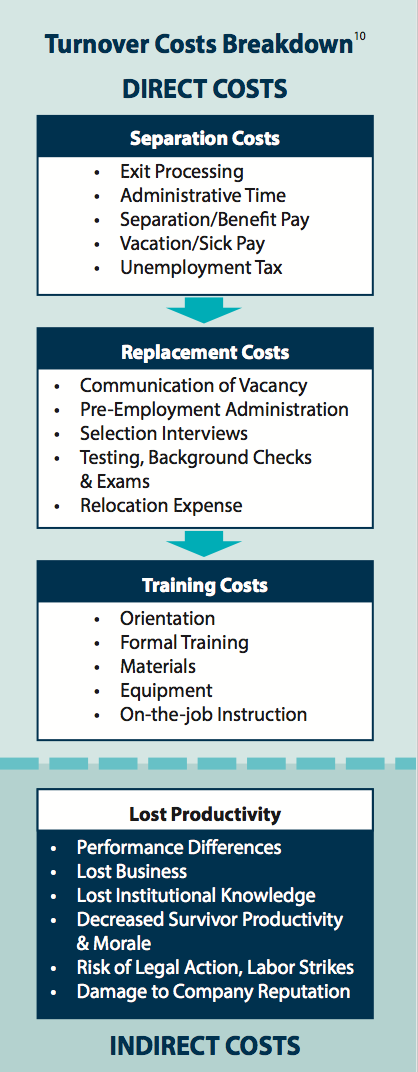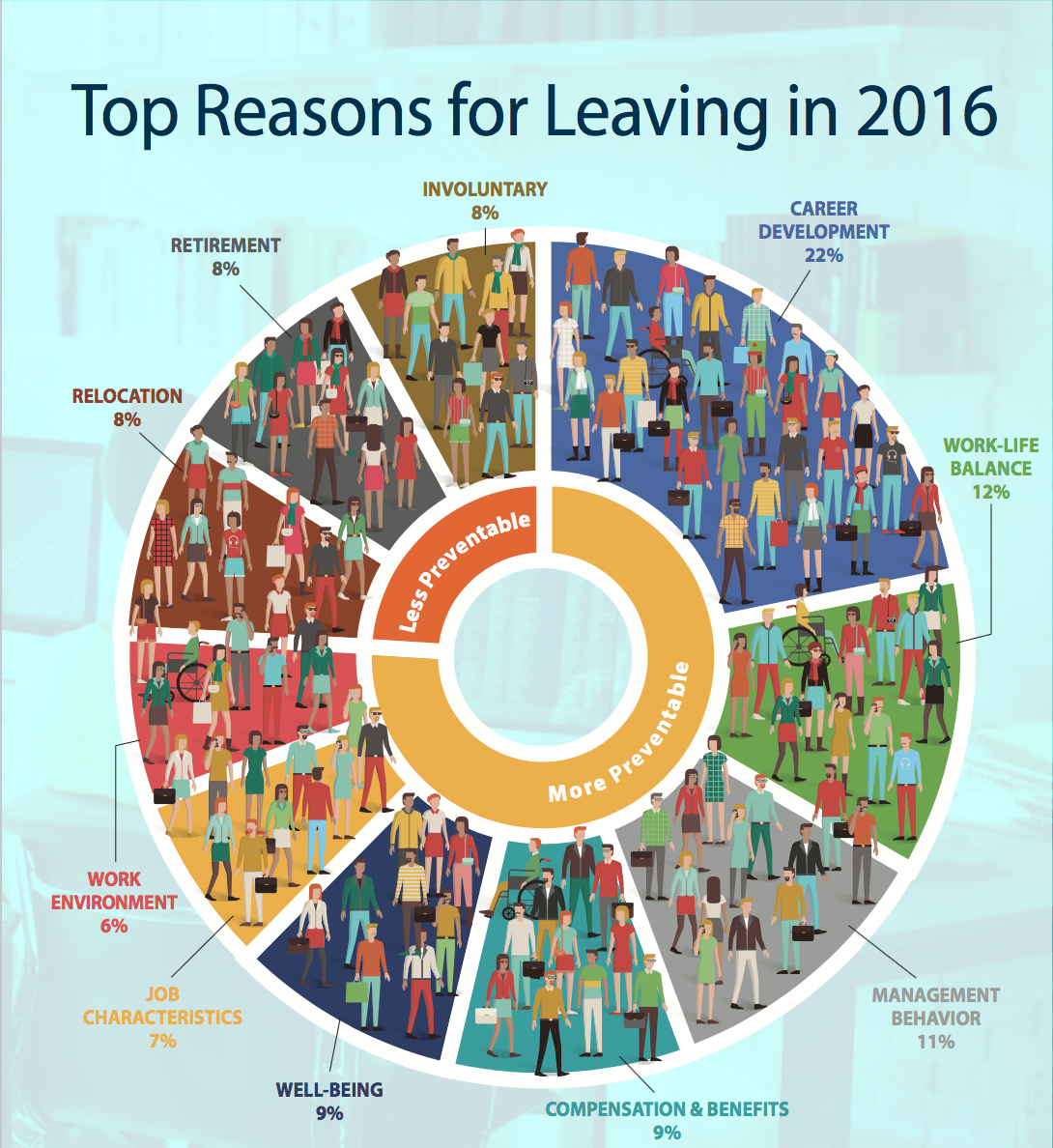Employee turnover is a sticky problem for HR managers, as replacing employees (especially good ones) can be costly. Understanding why employees stay or leave can give managers a leg up in this competitive job market where talented individuals have plenty of options to choose from. Fortunately, Work Institute recently published a report detailing reasons why employees leave their organizations. We highly recommend you to check it out; however, if you’re in a crunch for time, here are the key takeaways:
#1 Cost Of Employee Turnover
 Whenever an employee leaves, the business incurs both direct and indirect costs. Direct costs are put out to cover the separation, replacement, and training for new hires. Indirect costs, on the other hand, are reflected in the lost productivity. On average, Work Institute estimated that the cost of turnover is 33% of a worker’s annual salary. With a national average salary of $45,000, employers lose around $15,000 for each employee leaving. Of course, this number can be much larger in metropolitan areas where average salaries are higher.
Whenever an employee leaves, the business incurs both direct and indirect costs. Direct costs are put out to cover the separation, replacement, and training for new hires. Indirect costs, on the other hand, are reflected in the lost productivity. On average, Work Institute estimated that the cost of turnover is 33% of a worker’s annual salary. With a national average salary of $45,000, employers lose around $15,000 for each employee leaving. Of course, this number can be much larger in metropolitan areas where average salaries are higher.
#2 Ten Categories of Reason for Leaving, 75% Are Preventable
Work Instituted divided employees’ reasons for leaving into ten categories. They are:
- Career Development (opportunities for growth, achievement, and security)
- Work Environment (physical and cultural surroundings)
- Management Behavior (positive and productive relationships)
- Job Characteristics (ownership and enjoyment in manageable work)
- Compensation & Benefits (total rewards promised and received)
- Work-Life Balance (travel and scheduling preferences)
- Well-Being (physical, emotional, and family-related issues)
- Relocation
- Retirement
- Involuntary
Within these categories, there are 65 reasons why employees left their former companies. While Career Development is the biggest reason, other environmental and cultural reasons also play a major role. Note here that most of these factors are actually controllable and preventable if the company pays attention to their employees’ needs and opinions.

#3 ⅓ of All Turnover Occurs Within The First Year Of Employment
This fact is extremely alarming, because generally “it takes employees up to 3 – 6 months on the job before they add enough value to offset the cost of their hiring, onboarding, and compensation and benefits.” For this reason, if employees leave within their first year of employment, companies might realize little positive return (or even none at all) on these hires.
Intriguingly, this group of leavers is more likely to cite Job Characteristics, Well-being, and Work-Life Balance as reasons to leave than their long-term counterparts:
- Job Characteristics, as Work Institute pointed out, can be improved by “listen[ing] to workers to ensure appropriate preferences are met and expectations are set beginning with recruitment and throughout the onboarding process into the job itself.”
- Well-being and Work-life balance, on the other hand, is a continual process that companies need to work on all the time; they are the results of your workplace culture. If you focus on taking care of your employees and their dependents, their well-being and work-life balance are likely to improve. If, however, managers and companies consider their workers as machines to be exploited, then it is not a surprise that well-qualified employees choose to devote their time and effort somewhere else.
#4 Small Investments In Retention Yields High Returns
As mentioned above, it costs an average of $15,000 each time an employee leaves their company. That means that a $100,000 investment will pay for itself if it prevents seven employees from leaving if they otherwise haven’t. Of course, this number varies by companies, because a $100,000 might sound like a small fortune for some businesses and a drop in a bucket for others. Regardless, investing in your employee experience will set your organization apart from the thousands of others who are thirsty for the same talent that you have on your team.
“Those who rate their employer as fair or poor are 9.7 times more likely to look for a job within 12 months than those who rate their employer as excellent. Those who rate their employer as good or very good are 2.8 times more likely to look for a job within 12 months than those who rate their employer as excellent.”
Fortunately, there are a lot of small things you can do to create a better employee experience and reduce turnover. We have discussed at length on this blog about the ways you can take care of your employees. Below is a list of our readers’ favorites:
Benefits:
Communicating Benefits To Millennials
Soft Benefits Growing In Importance
Workplace Culture:
Practical Tips To Build A Culture Of Health
Courting Millennials: Lessons From Market Research
Wellbeing:
Improving Productivity By Cultivating Good Sleep
DIY: How Do I Organize A Step Challenge?
If you found this article helpful, feel free to share it with your friends and colleagues! As always, let us know if you like our content and what you’d like to see next on our blog, we’re always here to help!












